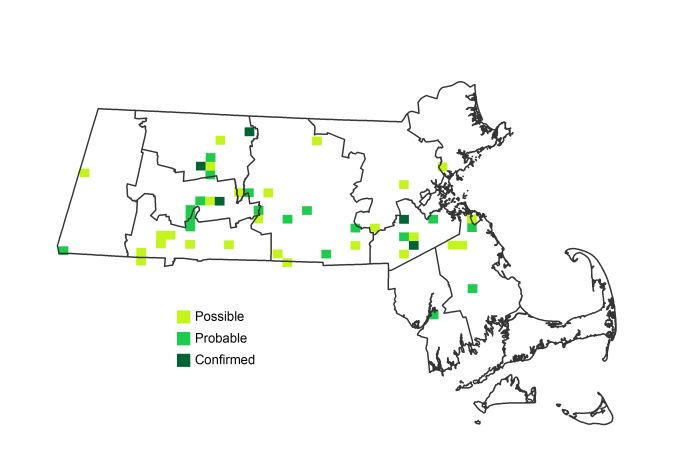Breeding Bird Atlases (BBA)
Find a Bird
Worm-eating Warbler
Helmitheros vermivorum

Local and strongly increasing
“The early bird gets the worm.” – English Proverb
The Worm-eating Warbler is a southern warbler species that has been slowly expanding northward in recent decades, and it is meeting with greater success than either the Cerulean Warbler or Prothonotary Warbler. These subtly plumaged warblers are native to the southeastern US, particularly the southern Appalachian Mountains and the Mississippi Delta. Though Worm-eating Warblers may once have bred on the wooded slopes of Massachusetts in the pre-Colonial period, the species was scarcely known by the Commonwealth’s early ornithologists. The lack of mature forest kept Worm-eating Warblers from colonizing the Commonwealth until relatively late in the game, after forests began to recover from the period of intense agricultural development of the 1800s.
Historic Status
Although most observers of birds in nineteenth-century Massachusetts described the Worm-eating Warbler as an accidental visitor from the south, the 1839 report prepared for the state legislature claimed that the bird “arrives from the south late in the spring, and retreats early, before the northern storms. It was not known to breed in this State until a nest was discovered in Cambridge by Mr. Rotch, who gave a specimen of the eggs to Dr. Brewer” (Peabody 1839). The loss of forest cover probably caused its near extirpation from the state, a trend that was reversed in the twentieth century as agricultural land succeeded back to forest. A singing male in Mount Washington brought suspicion of breeding in 1923, and by the 1930s nesting was authenticated in Berkshire County (Petersen & Meservey 2003). Nonetheless, breeding records in the state remained sparse for the next few decades.
Atlas 1 Distribution
A discreet bird in both plumage and voice, the Worm-eating Warbler was Confirmed in 6 blocks in Atlas 1. Dry rocky slopes with a good covering of leaf litter are the preferred haunts of the Worm-eating Warbler, and two such sites in Southwick established the species’ presence in the Berkshire Transition zone. Two more Confirmations in the Connecticut River Valley weighted Worm-eating Warbler’s distribution toward the western part of the state, although two Confirmations from Weston and Dover hinted at a broader distribution in Massachusetts than expected for this species. These isolated breeding Confirmations foreshadowed a more generous distribution during Atlas 2.
Atlas 2 Distribution and Change
With their long (for a warbler), pointed bills, Worm-eating Warblers specialize in prying open curled leaves to eat the insect larvae within. Such larvae may have been in ready supply during the inter-Atlas period because the Worm-eating Warbler increased considerably by the time of Atlas 2, from 6 total records in Atlas 1 to 49 in Atlas 2. Even though Atlas 2 had one fewer Confirmation than Atlas 1, Worm-eating Warblers were discovered all across the state. The Connecticut River Valley and Lower Worcester Plateau seemed to be particularly favored regions, and the southern Coastal Plains, particularly Norfolk County, also showed a fair presence of breeding Worm-eating Warblers.
Atlas 1 Map

Atlas 2 Map

Atlas Change Map

Ecoregion Data
Atlas 1 | Atlas 2 | Change | ||||||
Ecoregion | # Blocks | % Blocks | % of Range | # Blocks | % Blocks | % of Range | Change in # Blocks | Change in % Blocks |
Taconic Mountains | 0 | 0.0 | 0.0 | 2 | 8.0 | 4.1 | 2 | 13.3 |
Marble Valleys/Housatonic Valley | 0 | 0.0 | 0.0 | 0 | 0.0 | 0.0 | 0 | 0.0 |
Berkshire Highlands | 0 | 0.0 | 0.0 | 0 | 0.0 | 0.0 | 0 | 0.0 |
Lower Berkshire Hills | 0 | 0.0 | 0.0 | 2 | 6.5 | 4.1 | 0 | 0.0 |
Vermont Piedmont | 0 | 0.0 | 0.0 | 0 | 0.0 | 0.0 | 0 | 0.0 |
Berkshire Transition | 2 | 5.3 | 33.3 | 2 | 5.0 | 4.1 | -1 | -3.2 |
Connecticut River Valley | 2 | 3.6 | 33.3 | 11 | 16.9 | 22.4 | 8 | 16.7 |
Worcester Plateau | 0 | 0.0 | 0.0 | 5 | 5.7 | 10.2 | 2 | 4.2 |
Lower Worcester Plateau | 0 | 0.0 | 0.0 | 8 | 10.0 | 16.3 | 4 | 7.4 |
S. New England Coastal Plains and Hills | 1 | 0.4 | 16.7 | 15 | 5.3 | 30.6 | 11 | 4.9 |
Boston Basin | 1 | 1.8 | 16.7 | 1 | 1.8 | 2.0 | 0 | 0.0 |
Bristol and Narragansett Lowlands | 0 | 0.0 | 0.0 | 3 | 2.6 | 6.1 | 3 | 3.0 |
Cape Cod and Islands | 0 | 0.0 | 0.0 | 0 | 0.0 | 0.0 | 0 | 0.0 |
Statewide Total | 6 | 0.6 | 100.0 | 49 | 4.7 | 100.0 | 29 | 3.5 |
Notes
The Worm-eating Warbler shows a significant increasing Breeding Bird Survey trend in the New England/Mid-Atlantic Region and in the Eastern US overall.



